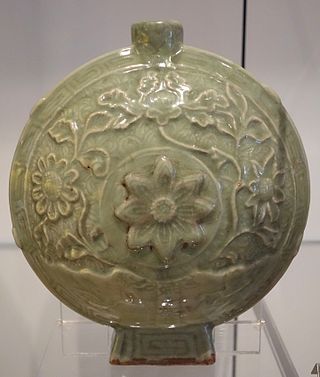
Longquan celadon is a type of green-glazed Chinese ceramic, known in the West as celadon or greenware, produced from about 950 to 1550. The kilns were mostly in Lishui prefecture in southwestern Zhejiang Province in the south of China, and the north of Fujian Province. Overall a total of some 500 kilns have been discovered, making the Longquan celadon production area one of the largest historical ceramic producing areas in China. "Longquan-type" is increasingly preferred as a term, in recognition of this diversity, or simply "southern celadon", as there was also a large number of kilns in north China producing Yaozhou ware or other Northern Celadon wares. These are similar in many respects, but with significant differences to Longquan-type celadon, and their production rose and declined somewhat earlier.

Pottery and porcelain is one of the oldest Japanese crafts and art forms, dating back to the Neolithic period. Types have included earthenware, pottery, stoneware, porcelain, and blue-and-white ware. Japan has an exceptionally long and successful history of ceramic production. Earthenwares were made as early as the Jōmon period, giving Japan one of the oldest ceramic traditions in the world. Japan is further distinguished by the unusual esteem that ceramics hold within its artistic tradition, owing to the enduring popularity of the tea ceremony. During the Azuchi-Momoyama period (1573-1603), kilns throughout Japan produced ceramics with unconventional designs. In the early Edo period, the production of porcelain commenced in the Hizen-Arita region of Kyushu, employing techniques imported from Korea. These porcelain works became known as Imari wares, named after the port of Imari from which they were exported to various markets, including Europe.

Korean ceramic history begins with the oldest earthenware from around 8000 BC. Throughout the history, the Korean peninsula has been home to lively, innovative, and sophisticated art making. Long periods of stability have allowed for the establishment of spiritual traditions, and artisan technologies specific to the region. Korean ceramics in Neolithic period have a unique geometric patterns of sunshine, or it is decorated with twists. In Southern part of Korea, Mumun pottery were popular. Mumun togi used specific minerals to make colors of red and black. Korean pottery developed a distinct style of its own, with its own shapes, such as the moon jar or Buncheong sagi which is a new form between earthenware and porcelain, white clay inlay celadon of Goryeo, and later styles like minimalism that represents Korean Joseon philosophers' idea. Many talented Korean potters were captured and brought to Japan during the invasions of Korea, where they heavily contributed to advancing Japanese pottery. Arita ware, founded by Yi Sam-pyeong opened a new era of porcelain in Japan. Another Japanese representative porcelain, Satsuma ware was also founded by Dang-gil Shim and Pyeong-ui Park. 14th generation of Su-kwan Shim have been using the same name to his grandfather and father to honor they are originally Korean, 14th Su-kwan Shim is honorable citizen of Namwon, Korea.

Langley Mill Pottery was located in Langley Mill, Derbyshire on the Derbyshire – Nottinghamshire border. From its establishment in 1865 to its final closure in 1982, the pottery went through five distinct periods of ownership, producing a wide range of stoneware ranging from salt glazed ink bottles, utilitarian items and tableware to high quality and original art pottery.
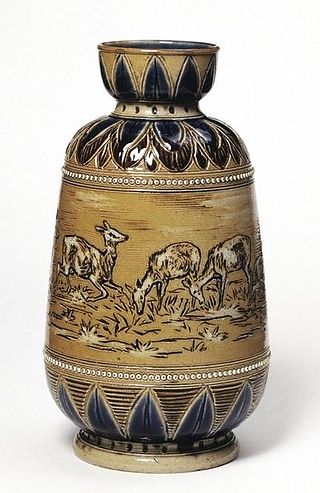
Royal Doulton is an English ceramic and home accessories manufacturer that was founded in 1815. Operating originally in Vauxhall, London, and later moving to Lambeth, in 1882 it opened a factory in Burslem, Stoke-on-Trent, in the centre of English pottery. From the start, the backbone of the business was a wide range of utilitarian wares, mostly stonewares, including storage jars, tankards and the like, and later extending to drain pipes, lavatories, water filters, electrical porcelain and other technical ceramics. From 1853 to 1901, its wares were marked Doulton & Co., then from 1901, when a royal warrant was given, Royal Doulton.

Jun ware is a type of Chinese pottery, one of the Five Great Kilns of Song dynasty ceramics. Despite its fame, much about Jun ware remains unclear, and the subject of arguments among experts. Several different types of pottery are covered by the term, produced over several centuries and in several places, during the Northern Song dynasty (960–1127), Jin dynasty (1115–1234) and Yuan dynasty (1271–1368), and lasting into the early Ming dynasty (1368–1644).

Shiwan ware is Chinese pottery from kilns located in the Shiwanzhen Subdistrict of the provincial city of Foshan, near Guangzhou, Guangdong. It forms part of a larger group of wares from the coastal region known collectively as "Canton stonewares". The hilly, wooded, area provided slopes for dragon kilns to run up, and fuel for them, and was near major ports.

Bolesławiec pottery, also referred to as Polish pottery, is the collective term for fine pottery and stoneware produced in the town of Bolesławiec, in south-western Poland. The ceramics are characterized by an indigo blue polka dot pattern on a white background or vice versa.

Art pottery is a term for pottery with artistic aspirations, made in relatively small quantities, mostly between about 1870 and 1930. Typically, sets of the usual tableware items are excluded from the term; instead the objects produced are mostly decorative vessels such as vases, jugs, bowls and the like which are sold singly. The term originated in the later 19th century, and is usually used only for pottery produced from that period onwards. It tends to be used for ceramics produced in factory conditions, but in relatively small quantities, using skilled workers, with at the least close supervision by a designer or some sort of artistic director. Studio pottery is a step up, supposed to be produced in even smaller quantities, with the hands-on participation of an artist-potter, who often performs all or most of the production stages. But the use of both terms can be elastic. Ceramic art is often a much wider term, covering all pottery that comes within the scope of art history, but "ceramic artist" is often used for hands-on artist potters in studio pottery.

Edwin Bennett, born in Newhall, Derbyshire, was an English American pioneer of the pottery industry and art in the United States, and founder of the Edwin Bennett Pottery Company of Baltimore, Maryland. Producing a variety of wares from the everyday to the fine and artistic, his company, originally founded in the 1840s as the Edwin Bennett Queensware Manufactory, continued in operation until forced to close during the Great Depression in 1936. Examples of Edwin Bennett pottery may be found in museums across the United States, including the Maryland Historical Society, the Philadelphia Museum of Art, the Metropolitan Museum of Art, and the National Museum of American History, as well as in private collections.
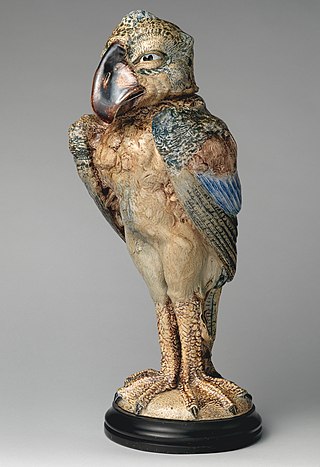
A Wally Bird is a tobacco jar or vase in the style of a grotesque owl or bird, first termed for the sculptural productions in this form by Robert Wallace Martin. These were typical examples of Martinware — salt-glazed stoneware which was produced by the Martin Brothers in their pottery; first in Fulham and then in Southall.

John Philip Elers and his brother David Elers were Dutch silversmiths who came to England in the 1680s and turned into potters. The Elers brothers were important innovators in English pottery, bringing redware or unglazed stoneware to Staffordshire pottery. Arguably they were the first producers of "fine pottery" in North Staffordshire, and although their own operations were not financially successful, they seem to have had a considerable influence on the following generation, who led the explosive growth of the industry in the 18th century.
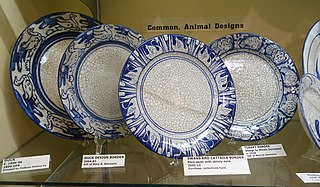
Dedham Pottery was an American art pottery company opened by the Robertson Family in Dedham, Massachusetts during the American arts & crafts movement that operated between 1896 and 1943. It was known for its high-fire stoneware characterized by a controlled and very fine crackle glaze with thick cobalt border designs. The Chelsea Keramic Art Works (1872–1889) and "Chelsea Pottery U.S." were earlier companies of the family.

American art pottery refers to aesthetically distinctive hand-made ceramics in earthenware and stoneware from the period 1870-1950s. Ranging from tall vases to tiles, the work features original designs, simplified shapes, and experimental glazes and painting techniques. Stylistically, most of this work is affiliated with the modernizing Arts and Crafts (1880-1910), Art Nouveau (1890–1910), or Art Deco (1920s) movements, and also European art pottery.
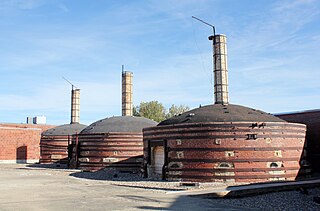
The Medalta Potteries was a Canadian ceramics manufacturing company in Medicine Hat, Alberta, that operated from 1916 to 1954. It was the first manufacturer in Western Canada to ship its products east of Ontario.

Staffordshire figures are a type of popular pottery figurine made in England from the 18th century onward. Many Staffordshire figures made from 1740 to 1900 were produced by small potteries and makers' marks are generally absent. Most Victorian figures were designed to stand on a shelf or mantlepiece and are therefore only modelled and decorated where visible from the front and sides. These are known as 'flatbacks'. They were shaped either by press moulding or slip casting.

Sang de boeuf glaze, or sang-de-boeuf, is a deep red colour of ceramic glaze, first appearing in Chinese porcelain at the start of the 18th century. The name is French, meaning "ox blood", and the glaze and the colour sang de boeuf are also called ox-blood or oxblood in English, in this and other contexts.

Auguste Delaherche was a French ceramicist, who was a leading figure in French art pottery through the Art Nouveau period. Like other leading French potters of the period, he was intensely interested in ceramic glaze effects of colour and surface texture. He began his career making stoneware, but later also made porcelain in his studio.
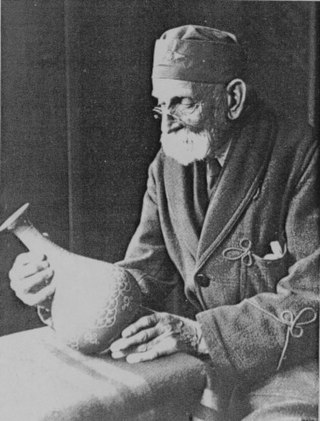
William Ault was an English potter, involved with a number of companies in the Staffordshire potteries and South Derbyshire making art pottery and more utilitarian wares.
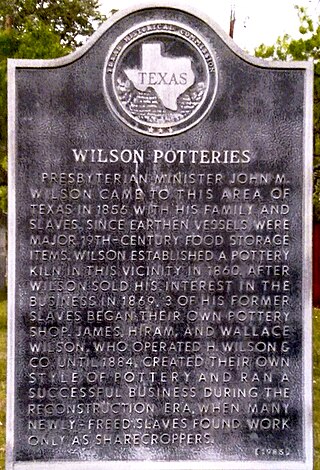
The Wilson Potteries were three related potteries that operated in Capote, Texas, near Seguin, in the latter half of the 19th century, supplying a wide swath of the state with locally-made stoneware vessels for food storage and preparation. One of these, H. Wilson & Co., is thought to be the first African-American-owned business in the state.




























